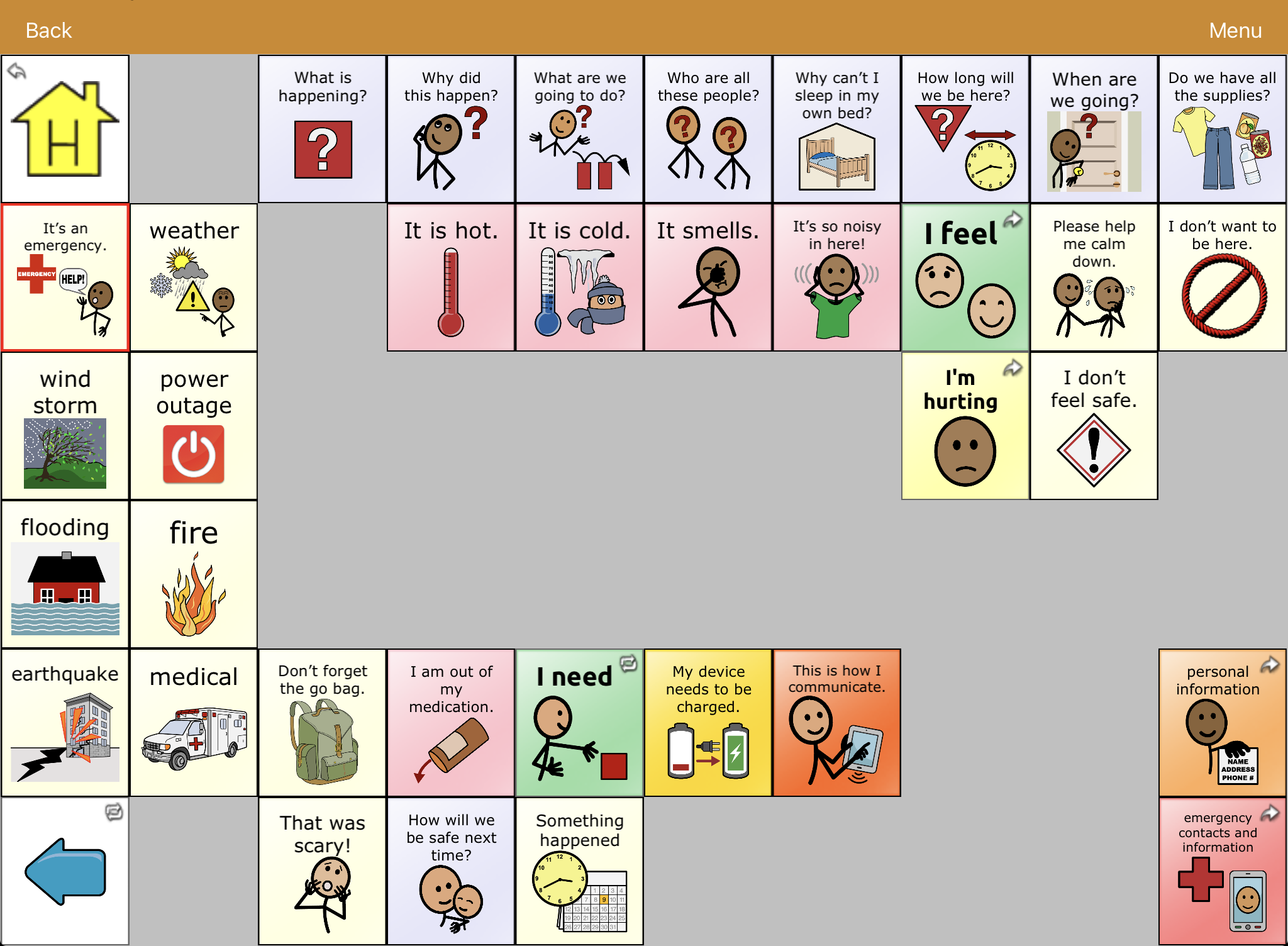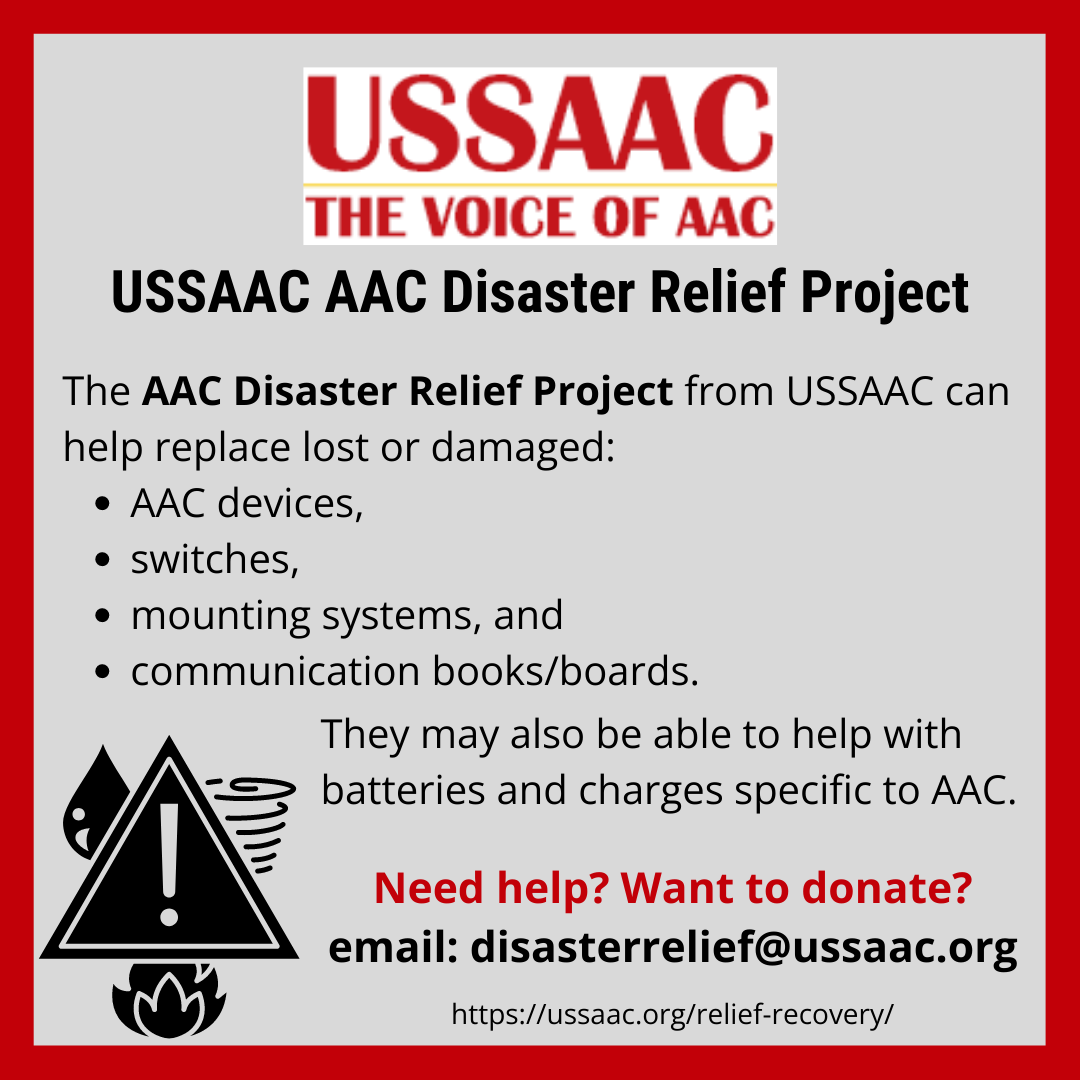by Kathy Smith, MSPA, SLP (Speech-Language Pathologist, retired); NWACS Board Member
reading time: 4 minutes
The theme for this blog post could not be better timed! September is National Preparedness Month. And I want to talk about emergency communication for people who use AAC systems.
These days, we often hear about emergencies in Washington state and other places, such as:
floods,
wildfires,
earthquakes,
landslides,
unexpected hospitalizations, etc.
Are we and our families prepared for a possible emergency?
We need to think about all types of emergencies:
natural disasters,
school/work emergencies,
a hospitalization of the person using an AAC system,
or even an illness of a primary caregiver, etc.
During any of these times, the emergency may prevent people who use AAC from using their usual communication systems. So, an emergency communication system needs to be available for everyone who uses AAC.
Twenty years ago, there was very little information on this topic. Last year (10/20/22), Mariam D. Boesch, et all, discussed this timely topic in the open-access article: Augmentative and Alternative Communication Disaster Preparedness: Roles, Responsibilities, and Opportunities for Speech-Language Pathologists and Other Professionals. The article reviews a survey completed by a small number of families. All the families included a person who uses AAC. The results showed almost all the families were not prepared for a disaster. And, most importantly, they did not have an emergency communication system set up for their family member.
How many AAC users whom we know have an emergency communication system?
Are the people familiar to us who use AAC prepared for a possible emergency?
What is an emergency communication system?
In general terms, an emergency communication system is anything that can meet the basic communication needs of the person in an emergency. For example, it could be a simple display on laminated paper. Or it could be a special display (or page) on an existing electronic communication system.
How do we begin developing an emergency communication system?
First, if we are the AAC user’s speech-language pathologist, we need to work with the family to explain the need and develop a plan of action. We need to think about the design of the emergency communication system that can meet the needs of any possible emergencies. The easiest might be to use the AAC system already being used and add a special emergency section or page. Remember that easy access to quick communication is important in emergency situations. The image below shows possible messages to include. The example includes often-used messages the user has on other pages in the system. These routine messages have been programmed into the emergency display at the same locations. Then generalized messages for any type of emergency can be included such as, “What is happening?’ or “I am scared.” Blank spaces allow for just-in-time programming for messages unique to that situation. For more examples of emergency displays/vocabulary, check out the resources section of the AAC and Emergency Preparedness page on the NWACS website.
Example of an emergency communication page designed in TouchChat HD AAC with WordPower
Of course, we also need to think about access and maintenance. Will the usual access method still be available during emergencies? Or should a backup access method be considered? Yes! There should always be a backup light-tech, non-electronic communication tool ready and available.
Should there be an information page for unfamiliar communication partners? Do the instructions for the communication partners include:
access method,
maintenance, and
storage of the emergency communication system?
To get you started, NWACS has created this "In Case of Emergency Communication Tips" template.
These emergency communication systems need to be easily accessible for speedy departure from home, school, or work. A ‘Family Go Bag’ already packed with everything needed for about two weeks is suggested. The ‘Go Bag’ should include things like:
medications,
clothing,
food, and
other basic needs, as well as
the emergency communication system and
critical documents
A ‘Stay Box’ is also suggested for times when you need to shelter in place for an extended period, such as during an earthquake.
Creating emergency communication systems takes time. Unusual and unexpected natural disasters are in the news more and more. In light of those disasters, do we have the time to build an emergency communication system? The answer has got to be ‘yes.’ It is not too soon for the team, including caregivers, to begin planning emergency communication system(s) for each user of an AAC system. Are we prepared?
To help you take action and prepare for the unexpected, NWACS has collected resources on our AAC and Emergency Preparedness webpage. Another good resource to start with is the Emergencies and Disasters: Readiness page on the USSAAC website. They have a free course that helps guide you through the initial steps of disaster preparedness.
The AAC Disaster Relief Project from USSAAC can help replase lost or damaged AAC devices, switches, mounting systems, and communication books/board. They may also be able to help with batteries and chargers specific to AAC.
And finally, we can be advocates for any person who uses an AAC system. Even for those who may be unfamiliar to us. USSAAC has a donations-based program to help replace AAC systems that have been damaged beyond repair in a disaster.
To donate, email USSAAC at: disasterrelief@ussaac.org
Learn more about the USSAAC AAC Disaster Relief Project here: https://ussaac.org/relief-recovery/
References:
Boesch, Miriam & Begley, Elizabeth & Blackstone, Sarah & Caswell, Tina. (2022). Augmentative and Alternative Communication Disaster Preparedness: Roles, Responsibilities, and Opportunities for Speech-Language Pathologists and Other Professionals. Perspectives of the ASHA Special Interest Groups. 7. 1-7. 10.1044/2022_PERSP-21-00274
USSAAC Emergencies and Disasters: Readiness webpage
Related Resource:





